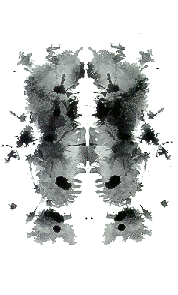Brands on the Run: Left Brain/Right Brain
In this month's WIRED, Daniel Pink writes an article about the supposed economic-and cultural-shift to what he refers to as the "conceptual" age. If the information age cracked the code of nature's functions and reduced images, and logic-based work to as few functions as possible, the conceptual age is the net result of this on human production. As Pink puts it, human labor has been dominated up until now by the left brain; number-crunching, logic-driven, sequential work, what is referred to as "knowledge work". The result is that traditional families are raised to aim towards a few select industries-law, medicine, business. When automation reduces these tasks and puts them in the hands of machines or offshore workers, these jobs will become less lucrative, and the more abstract and chaotic right brain will suddenly see its stock rise. While the argument is bloated-the kind of monumental paradigm shift used as a thesis for a successful pop science book-one of the effects that Pink talks about caught my eye-
"The Information Age has unleashed a prosperity that in turn places a premium on less rational sensibilities - beauty, spirituality, emotion. For companies and entrepreneurs, it's no longer enough to create a product, a service, or an experience that's reasonably priced and adequately functional. In an age of abundance, consumers demand something more. Check out your bathroom. If you're like a few million Americans, you've got a Michael Graves toilet brush or a Karim Rashid trash can that you bought at Target. Try explaining a designer garbage pail to the left side of your brain! Or consider illumination. Electric lighting was rare a century ago, but now it's commonplace. Yet in the US, candles are a $2 billion a year business - for reasons that stretch beyond the logical need for luminosity to a prosperous country's more inchoate desire for pleasure and transcendence."

While he only touches on it briefly, Pink argues that emotional branding is the result of abundance; a market cluttered that with interchangeable product, marketed to a culture with an endless desire for consumption. Beauty, chaos, abstraction, disorientation, the ambience of spiritual experience-these all become tangible, marketable commercial properties. Emotional branding is the next phase after postmodern branding-rather than manufacture authenticity through self-conscious product placements ( Energizer, Geico et al) emotional branding works to produce authentic content external to the product, creating the association between the brand and the object second. Whether or not these associations are genuine reflections of the product or "arbitrary"associations is a product specific question that's been asked since Roland Barthes wrote the newspaper column that became Mythologies-and a question I don't want to attempt to answer here. What I'm interested in is the art products produced in the branding proccess and how they communicate ideas, or feelings, to their audience.
First, does Pink's argument even hold up? Is branding in its current form a result of the information age's tendency to exhaust-or render obsolete-our left brain? Advertising has looked to appeal to the heartstrings of consumers since day one, but there is a wide difference between the origins of advertising and the manufactured transcendence of today. The heart-strings being applied in early 20th century advertising were logical and functional. Behaviorist psychology was the gospel of advertisers, who believed to a condescending degree that interacting with consumers was an exercise in deploying signifiers to Pavlovian effect. This deterministic, over-simplified line of thought originates from the same cultural goo as eugenics, national socialism and fascist propaganda. Humans were merely adjustable cogs which could be reduced to a series of functions, their every whim accompanied by a random biochemical button which could be pressed repeatedly.

Advertising culture as arrogant as it was, it was not long before speeches from conferences leaked to the public, to the extreme discomfort of the public, who realized they were being treated, literally in many cases, like cattle. This embarasment forced advertisers to shift from coercion and manipulation to much more subtle forms of persuasion. They do this through associations, creating a situation, negative or positive, and connecting it with the product. Between the first and second world war, advertising comes into its own as an industry, economically powerful enough to be the focus of the new capitalism. It draws on a history of newspaper placements that work by promising lofty, unrealistic goals to consumers, using language and visuals to persuade consumers that their soaps are life-affirming and their homes and are necessary for happy marriages. After manufacturing discomfort and cartoonishly lofty goals, post-war advertising took on a new form, one which provided a service in itself. With rapidly changing media landscape, transforming the atmosphere into a visual and sonic one, aesthetic perfection and artistic authenticity were not unrealistic goals for advertisers. What happens next is, essentially, that consumers are told exactly what they want to hear. It's here that advertising becomes a supplementary 'experience' rather than just misdirection. Raymond Williamsaddresses the contradiction this presents in "The Magic System":
"It is impossible to look at modern advertising without realizing that the material object being sold is never enough: this indeed is the crucial cultural quality of its modern forms. If we were sensibly materialist, in that part of our living in which we use things , we should find most advertising to be of an insane irrelevance. Beer would be enough for us, without the additional promise that in drinking it we show ourselves to be manly, young in heart, or neighbourly. A washing machine would be a useful machine to wash clothes, rather than indication that we are forward looking or an object of envy to our neighbours. But if these associations sell beer and washing-machines, as some of the evidence suggests, it is clear that we have a cultural pattern in which the objects are not enough but must be validated, if only in fantasy, by associations with social and personal meanings which in different cultural pattern might be more directly available. the short description of the pattern we have is magic: a highly organized and professoinal system of magical inducements an dsatisfactions, functionally very similar to magical systems in simpler societes..."

Commodities are made from the compression of materials with functions and their abstractions-the emotional component we associate with a "brand" but could easily be a result of word of mouth or public perception. The Brand is "right brain" appeal-functionality a "left brain" project, the purchasing decision occuring in the oblique space between the two. Advertising as a language and an industry exists in its current form as a result of a certain stage of capitalism, as well as the pervasiveness of mass media. Consumers can afford to purchase items on a higher level than ever before, and media allows concepts to reify and to be at all places at once. "Materialism" was never a capitalist problem, although an overabundance of materials was. The transition from an industrial to an information to a conceptual society is one in which our values shift from our rations to our rationale-from the physical fixes we get from sustenance and pleasure to the emotional associations that brought us there in the first place. In a completely right-brain world, it wouldn't be products we're sold-we would buy those on our own, knowing in advance what we want. In a right brain society, we would be sold advertisements-and we would like it.
In order to transition to this world, where emotional abstractions are recognized as the only consumer products worth marketing, a few changes would have to take place. First, corporations, having no way to copyright a feeling or a sense of self, would have to tighten the noose around intellectual property. Art and music are really feeling-machines, anyway, their transformation into intellectual property to consolidation of a certain series of feeling-provoking patterns. While each piece of music or art can be interpreted differently, 'pop music' and culture works on the assumption that society, in concert, can produce mutual meanings onto media objects. This is what's so beautiful about pop culture moments-they are shared cultural experiences, bonding exercises between millions of people. Consolidating pop culture intellectual property is quite literally the commodification of a feeling, a sensation, a sense of self.
Second, advertising would become a form of citizen authorship. Branding expert Douglas Holt believes this is the end product of consumer/advertiser relationships- a tightening circles in which the corporation and citizen realize they are occupying the same environment. In order to bypass the bullshit, advertisers will produce content in film and music without the smokescreen of authenticity or irony to create a narrative for their product. Their productions would simply be extensions of the product, performances in which Nike or Coca Cola allow their products to express themselves in a culturally relevant manner, producing 'authentic' emotional and artistic product that surpasses the material product.
While it's difficult to imagine a completely right-brained society, it is easy to see that our relationships to objects are governed by a force field of abstraction that is being penetrated much faster by advertisers than by ourselves. The first step to becoming media-literate about this is to be honest about what it is in consumer goods that make us happy-because as much as you can claim that people are "telling you to buy shit you don't need", they're not the ones injecting the dopamine in your brain. That rush is from a personal experience, a transcendant experience in a consumer good that you find satisfying, in a queer space that only your right brain understands.



0 Comments:
Post a Comment
<< Home